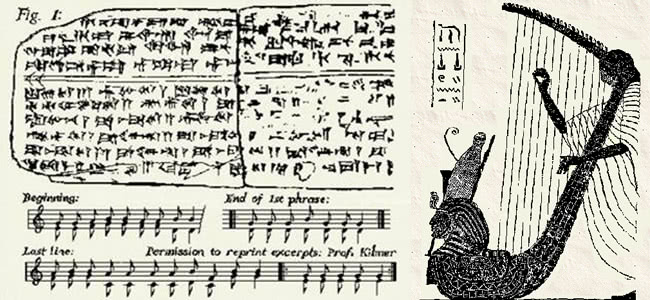Archaeologists have already found the world’s oldest instruments – a series of bone flutes excavated in South Germany – but what about the world’s oldest music?
It’s the Ancient Syrians (as in the civilisation, though that is a cool band name) can lay claim to writing the world’s first ever song. Called the ‘Hurrian Hymn no. 6’, the short piece of music was thought to be composed over 3,400 years ago and a recreation of the short melody shows that it’s not as strange as you’d might expect.
In fact, with its dinky keyboard notation and simple plink-plonk rhythm, it sounds quite a lot like something you’d hear from a retro videogame soundtrack than something carved into clay thousands and thousands of years ago.
The piece of music was discovered and deciphered by Professor Anne Draffkorn Kilmer from a series of tablets containing notation that were dug up in the Syrian city of Ugarit (modern Ras Shamra) in the early 1950s. First transcribed and performed for a published essay by Professor Kilmer in the 70s, the piece of music has once again gained recognition with some aural examples turning up online.
French archaeologists first excavated the clay tables in the early 1950s after which Professor Kilmer poured over the cuneiform script – a very early form or writing – on the dug up tablets for nearly 15 years. Her research eventually led her to decipher the hurrian language as a form of hymnal with attached notation.
The discovery was thought to be the oldest preserved version of notation in history, predating the next earliest find by some 1,400 years and once transcribed and played, contained very obvious signs of prehistoric melody and harmony, as an Greenwich Publishing essay entitled Evidence Of Harmony In Ancient Music points out.
By 1972, Prof. Kilmer – then a professor of Assyriology at the University of California and curator at the Lowie Museum of Anthropology at Berkeley – made an intepretation of the song’s notation for her book Sounds From Silence, which came with a CD recording of the piece, in collaboration with working with colleagues Richard L. Crocker and Robert R. Brown.
The researchers found that the ancient text was split in two sections, the top section contained words while the bottom contained instructions for instruments to play.”We are able to match the number of syllables in the text of the song with the number of notes indicated by the musical notations,” said Prof. Kilmer of the ‘Hurrian Hymn no. 6’.
The piece of music demonstrates a grasp of harmony and what we now know as the Western major scale nearly 1,400 years ahead of when musicologists believe it was first introduced – by the Ancient Greeks nearly 2,000 years ago. A discovery that “revolutionized the whole concept of the origin of western music,” as scientist Richard L. Crocker put it.
You can read more about the origins and implications of the Ancient Syrian piece here or take another listen and see if you don’t picture the glory days of whiling away the hours on your Game Boy and Super Nintendo. Now we just need to wait for some cheeky DJs to figure out a mash-up mix…

































